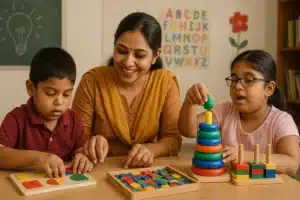
Source: toddlersread
The “Silent E Rule” is an important spelling rule in English that often changes how words are pronounced. The special job of the letter “e” at the end of a word convert short vowel sounds into long ones and make vowels say their name. For instance, the word “mad” becomes “made,” and “bit” turns into “bite,” all thanks to the Silent E Rule. This is a simple rule with which young learners improve their reading and spelling skills, making it a beneficial tool for teaching phonics.
The Many Jobs of the Letter E
The letter “e” might appear small, but it does a lot in the English language, mainly when it follows the this rule.
Here are The Many Jobs of the Letter E:
Converts short vowels into long
The addition of a Silent E modifies the sound of the vowel before it. For instance, hop becomes hope, here the “o” is modified from a short sound to a long.
Silent but important
Though you don’t pronounce the final “e” in words like ride and kite, it changes the vowel from short to long, giving a new meaning.
Helps with spelling
The Silent E is also used in words like give and blue to keep the word from ending with “v” or “u,” making it easier to spell and recognize.
About the Silent E Rule
About the Silent E Rule: When a word has a vowel, followed by a consonant, and ending with an “e,” the vowel sound shifts from a short sound to a long one.
Let us see a few examples of this rule:
Cap becomes cape
The short “a” in “cap” changes to a long “a” in “cape.”
Tim becomes time
The short “i” in “Tim” becomes a long “i” in “time.”
Hop becomes hope
The short “o” in “hop” converts to a long “o” in “hope.”
Learning this rule helps students easily understand how adding a Silent E affects word pronunciation and meaning.
Activities to Teach Silent E
Teaching the Silent E Rule can be made more fun and engaging with the right activities.
Here are a few interactive Activities to Teach Silent E:
Word sorting
Have students sort pairs of words like mad/made and bit/bite to see how the Silent E changes the sound and meaning of the word.
Flip cards
Make word cards where children can add or take away the Silent E to see how it changes words like not/note or rip/ripe.
Fill-in-the-blank
Provide worksheets with missing Silent E (e.g., tub/tub___) for students to fill in, showing the correct word.
Silent E quest
Ask children to find words in books, magazines, or the surroundings that follow this Rule, such as bake, home, stone, cute, etc. These Activities to Teach Silent E make learning fun and help children grasp the Silent E Rule more effectively.

Source: leader
More Tips for Teaching Silent E
Here are a few More Tips for Teaching Silent E in the classroom:
Visual aids
Use charts or posters showing how adding a Silent E changes words like rat to rate, man to mane, etc.
Read-aloud practice
Read words out loud with and without the Silent E, like cub/cube or pin/pine, so students can hear the difference.
Reinforce regularly
Keep practicing with new words that follow the Silent E Rule, such as tap/tape or rob/robe, to help students master the concept.
This rule is a valuable tool that helps young readers and spellers develop confidence. By incorporating fun activities and continuous practice, children can easily grasp this rule and apply it to their reading and writing skills.
Phonics Teacher Training
Phonics is one of the most effective approaches to teaching young children how to read, helping them comprehend the letter-sound connection. For passionate educators keen on early childhood education, Phonics Teacher Training offers essential tools and techniques to enhance literacy instruction. This specialized training equips teachers with the skills to make reading effortless and enjoyable for children by splitting down words into easy, manageable sounds.
Learning to read is one of the most essential skills with which children can flourish in school and life.
Phonics Teacher Course helps educators:
- Enhance children’s reading fluency and comprehension.
- Equip students with decoding skills, entitling them to tackle new words with confidence.
- Manage learning challenges early, such as difficulties with word identification or pronunciation.
Vidhyanidhi Education Society offers a thorough Phonics Teacher Training course, developed to equip educators with everything needed to excel in phonics instruction. This Phonics Course covers all facets of phonics teaching, from primary letter sounds to advanced phonetic patterns.
Some of the key benefits of enrolling in the Phonics Course include:
Hands-on learning
Interactive sessions that give teachers practical experience in applying phonics methods.
Flexibility
The Phonics Teacher Course is available both online and offline, making it accessible for educators with different schedules.
Certification
Upon completion, teachers receive a recognized certification that enhances their professional credentials.
Expert Guidance
The Phonics Course is conducted by adept instructors who provide ongoing support and feedback.
Phonics Teacher Course is a useful course for educators devoted to building a strong literacy foundation for young learners. Phonics Courses like the one presented by a reputed institute like Vidhyanidhi Education Society (Govt. Regd.) empower teachers with the tools, strategies, and confidence to make a lasting impact in their classrooms.
Master the Silent E Rule and more! Join Vidhyanidhi Education Society’s Phonics Course today!
For more details of Phonics Course Call/Whatsapp on +919869866277 / +919869546913
To download brochure of Phonics Course, Click Here!
FAQ
How to Learn Phonics as a Teacher?
You can learn phonics effectively through training programs like the Phonics Course offered by Vidhyanidhi Education Society, providing you with essential teaching tools.
How Long is the Phonics Course?
The Phonics Course takes just 6 days to complete, equipping you with the skills to teach phonics confidently and effectively.
Where so I Start Teaching Phonics?
You can start teaching phonics in preschools, by offering your own phonics classes, incorporating it into your own classrooms, or teaching phonics to special children.



